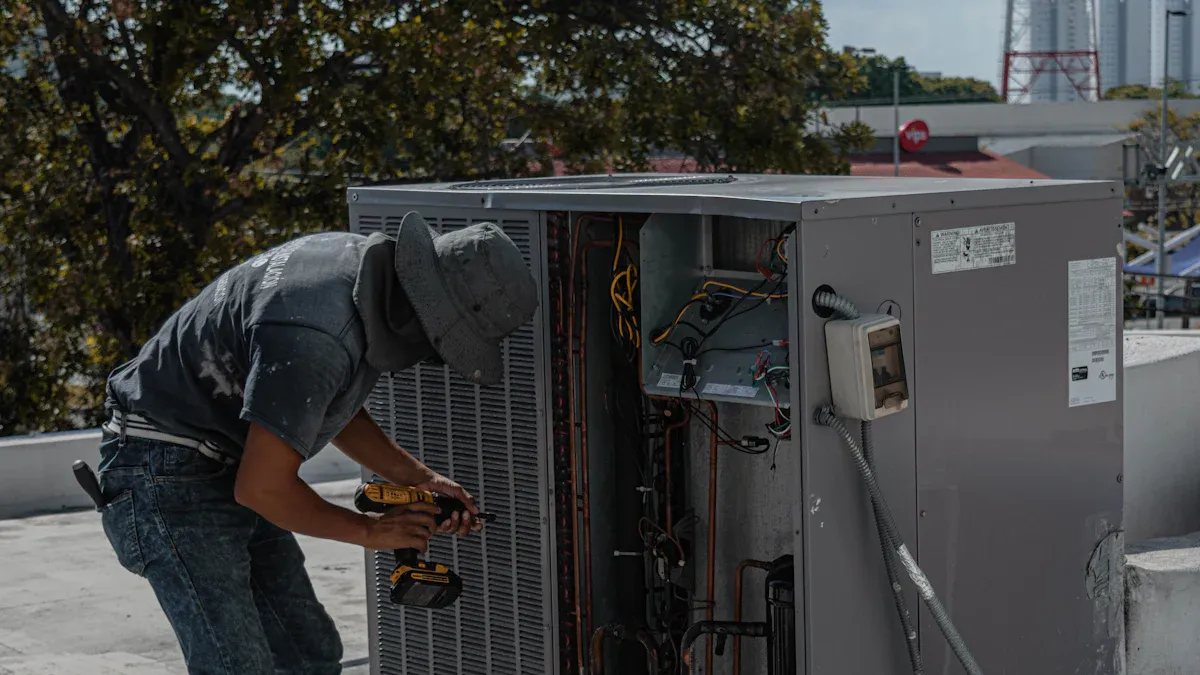Understanding Copper Line Sets for Air Conditioning Systems

Copper line sets for air conditioners are essential components of air conditioning systems. They consist of two copper tubes that connect the indoor and outdoor units. These tubes facilitate the transfer of heat, helping to cool or warm your space efficiently. One tube, known as the liquid line, carries liquid refrigerant, while the other, called the suction line, transports gas refrigerant back. This continuous loop ensures your home remains comfortable.
Using a copper line set for air conditioners enhances system performance. Smaller copper tubes can reduce tube volume by 41%, while also allowing coil sizes to shrink by 57%. This leads to improved energy efficiency and cost savings. These advantages make copper line sets for air conditioners a critical choice for dependable and cost-effective cooling solutions.
Key Takeaways
Copper line sets are important for air conditioners. They link indoor and outdoor units to keep cooling and heating working well.
Insulating the liquid line stops heat loss. This makes the system work better and saves energy.
Taking care of copper lines, like checking for leaks or damage, avoids expensive repairs and makes your air conditioner last longer.
Picking the correct size and type of copper line set helps the system work better and lowers energy costs.
Replacing broken line sets on time improves cooling and stops more damage to the air conditioner.
Parts of a Copper Line Set for Air Conditioner
Copper line sets are important for air conditioners to work well. They have two main parts: the liquid line and the suction line. Each part helps the system cool and heat properly.
Liquid Line
The liquid line moves liquid refrigerant from the outdoor unit to the indoor unit. This keeps the cooling cycle running smoothly. The size of the liquid line matters. If it's too big or small, refrigerant flow can be affected. Shorter lines are better because they lower pressure drops and improve performance.
Insulation is very important for the liquid line. Without it, heat can enter the refrigerant and reduce cooling power. Use insulation at least 1 inch thick to stop this problem. Sealing the joints tightly prevents leaks that could hurt the system. Regular checks help find damage early and keep the line in good shape.
Protecting the liquid line from weather is also necessary. Sunlight and moisture can harm the insulation, causing heat transfer and less efficiency. Taking care of these issues ensures the liquid line works well for your air conditioner.
Suction Line
The suction line carries gas refrigerant back to the outdoor unit. It helps keep the cooling cycle going and returns oil to the compressor. Without enough oil return, the compressor might break, leading to expensive repairs. Careful design and installation prevent these problems.
Friction inside the suction line can cause pressure loss, lowering efficiency. To avoid this, make sure the line is smooth and clean. The speed of the refrigerant also matters. If it's too slow, oil may not reach the compressor. Planning during setup can fix these issues.
Height differences between the indoor and outdoor units can affect the suction line. If the outdoor unit is higher, oil traps might form and block refrigerant flow. Good routing and setup solve these problems. Regular maintenance, like checking for rust or dirt, keeps the suction line working well.
Knowing how the liquid line and suction line work helps you see why copper line sets are important. Whether you use a mini-split, ductless air conditioner, or regular HVAC system, these parts are key for reliable cooling.
Role of Refrigerant Line Sets in Air Conditioning Systems
Helping Refrigerant Move
Refrigerant line sets help move refrigerant between units. This movement keeps your air conditioner working properly. The liquid line carries liquid refrigerant to the indoor unit. The suction line brings gas refrigerant back to the outdoor unit. This cycle keeps cooling or heating running smoothly.
Good refrigerant lines stop leaks and pressure problems. Smooth refrigerant flow makes the system work better. Badly installed lines can block refrigerant or slow it down. This makes the system use more energy. Checking and fixing the lines often keeps them working well.
Supporting Heating and Cooling
Refrigerant lines do more than just move refrigerant. They also help with heating and cooling cycles. During cooling, refrigerant takes heat from inside and releases it outside. During heating, it brings warmth inside. The lines keep refrigerant at the right pressure and temperature.
Well-kept lines stop refrigerant loss and temperature changes. These problems can make your system less comfortable and cost more money. Taking care of the lines keeps your system working all year.
Improving System Efficiency
Your air conditioner works better with good refrigerant lines. Well-installed and maintained lines save energy and protect system parts. This lowers bills and helps your system last longer.
Here are some examples of how good lines help:
Example | Results |
|---|---|
HVAC Projects | 30% lower heating costs, fewer repair calls |
Denver Strip Mall | Higher cost upfront, but savings in four years, happier tenants |
Los Angeles Charter School | 22% lower energy costs, better air quality, fewer complaints |
These examples show how good refrigerant lines save money and improve performance. Strong, insulated copper lines last longer and work better. Regular care stops leaks and keeps insulation strong.
Knowing about refrigerant lines helps you see their importance. Installing them right and keeping them in good shape ensures comfort and savings for years.
Key Things to Know for Installing a Line Set
Picking the Right Size
Choosing the right size line set is very important. First, check the manufacturer’s guide for your system. This ensures the line set fits your mini-split or multi-zone system. Then, measure the distance between the indoor and outdoor units. Line sets are usually 15, 25, or 50 feet long. Some systems can handle up to 150 feet. A minimum of 15 feet is often needed for proper use. Lastly, pick copper line sets instead of aluminum ones. Copper is stronger, bends easier, and works well with modern refrigerants like R410A.
Why Insulation Matters
Insulation helps your line set work better. Without it, heat can enter or leave the lines. This lowers your system’s cooling or heating power. Insulated lines also stop condensation, which can cause water damage or mold. Use good insulation and wrap it tightly around the lines. For outdoor setups, use covers to protect insulation from sunlight and rain. Check insulation often for damage to keep your system working well.
How to Install It Correctly
Installing a line set the right way avoids problems. First, use a flaring tool to make a smooth flare on the copper tube. The flare should fit the flare fittings perfectly. Add refrigeration oil to the fitting threads for a tight seal. Tighten the fittings with a torque wrench as the guide says. After connecting, insulate the lines to stop heat loss or gain. Test for leaks by doing a pressure test. Remove air and moisture by evacuating the lines. If you’re unsure, ask a professional to help avoid mistakes.
Maintenance and Replacement of Linesets
Tips for Regular Maintenance
Taking care of your copper lineset keeps your air conditioner working well. Regular maintenance avoids expensive repairs and helps it last longer. Follow these simple steps to keep your lineset in good shape:
Check the tubing often for cracks, scratches, or color changes. These can show damage that might cause leaks.
Wipe the tubes with a soft cloth and gentle cleaner. Dry them completely to stop rust from forming.
Add lubricant to parts connected to the copper tubing. Use the type recommended by the manufacturer to avoid harm.
Have a certified HVAC technician inspect your system regularly. They can find problems early and keep it running smoothly.
Doing these steps protects your lineset and saves you from surprise repair costs.
Signs That Replacement Is Necessary
Knowing when to replace your lineset can prevent bigger issues later. Watch for these warning signs:
Refrigerant Leaks: If refrigerant levels drop or you see oily spots near the tubing, it might need replacing.
Poor Cooling or Heating: Damaged lines can block refrigerant flow, making your system less effective.
Visible Damage: Cracks, rust, or worn insulation mean the lineset may not work properly anymore.
Unusual Noises: Hissing or bubbling sounds could mean leaks or clogs in the tubing.
Fixing these problems quickly keeps your air conditioner working its best.
Benefits of Timely Replacement
Replacing a damaged lineset on time has many benefits. First, it makes your system more efficient, saving energy and lowering bills. Second, it stops damage to other parts like the compressor, which can be costly to fix. Third, a new lineset improves how well your air conditioner cools and heats your home.
Replacing on time also helps your system last longer. Fixing problems early means fewer replacements are needed. Choosing a strong copper lineset gives you reliable performance for years.
Tip: Always hire a professional technician to replace your lineset. This ensures it’s installed correctly and works with your system.
Copper line sets are important for air conditioners to work well. They help refrigerant move between indoor and outdoor units. This keeps cooling and heating cycles running smoothly. Taking care of the lineset stops expensive repairs and makes the system last longer.
Part | Job | Why Maintenance Matters |
|---|---|---|
Liquid Line | Moves refrigerant from outside to inside. | Checking for leaks and fixing insulation keeps it working efficiently. |
Suction Line | Sends gas refrigerant back outside. | Looking for damage during checks helps it work its best. |
Using strong copper line sets and keeping them in good shape gives you better cooling and lower energy bills for many years.
FAQ
What does insulation do on copper line sets?
Insulation stops heat from moving in or out. It keeps refrigerant at the right temperature, helping your system cool and heat better. It also prevents water damage and mold from forming.
Tip: Check insulation often for damage to keep it working well.
How can you tell if your copper line set needs replacing?
Watch for refrigerant leaks, weak cooling, visible cracks, or strange sounds. These problems mean the line set might not work properly anymore.
Note: Replacing damaged lines quickly saves money and keeps your system running well.
Can you install a copper line set by yourself?
Installing a line set needs special tools and skills. Doing it wrong can cause leaks or make the system less efficient.
Alert: Always hire a trained HVAC technician to install it correctly.
Why is copper better than aluminum for line sets?
Copper lasts longer, bends easier, and works with modern refrigerants. It also resists rust better than aluminum, making it more reliable.
Emoji Insight: 🛠️ Copper’s strength makes it the best choice for air conditioners.
How often should you take care of your copper line set?
Check the line set every six months. Clean it, look for damage, and make sure the insulation is good. Regular care helps your system last longer.
Reminder: Get a professional to inspect it once a year for the best results.
See Also
Exploring How Copper Tubing Has Transformed Air Conditioning
Understanding the Role of Copper Tubing in AC Systems
The Revolutionary Benefits of Pure Copper Pipes for AC


